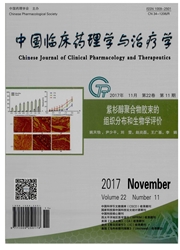

 中文摘要:
中文摘要:
目的观察人参皂苷Rh2(ginsenoside Rh2,G-Rh2)对荷Lewis肺癌小鼠抗肿瘤作用并探讨其作用机制。方法建立Lewis肺癌实体瘤模型,观察G-Rh2的抗肿瘤作用、观察肿瘤内血管密度(MVD),以及免疫组化法观察瘤体血管内皮生长因子(VEGF)的表达。结果 0.3 mg·kg^-1、1.0 mg·kg^-1和3.0 mg·kg^-1G-Rh2组对Lewis肺癌小鼠实体瘤均有抑制作用(P〈0.05);1.0 mg·kg^-1和3.0 mg·kg^-1 G-Rh2组MVD明显低于对照组(P〈0.05);免疫组化结果显示,0.3 mg·kg^-1、1.0 mg·kg^-1和3.0 mg·kg^-1 G-Rh2组瘤组织内的VEGF蛋白表达阳性率均低予对照组(P〈0.05)。结论 G-Rh2可抑制Lewis肺癌生长及抑制肿瘤新生血管生成的作用,可能是通过降低VEGF表达来实现的。
 英文摘要:
英文摘要:
Objective To investigate the antitumor effect of G-Rh2 on Lewis Pulmonary Carcinoma bearing in Mice and its mechanisms. Methods The entity tumor model of Lewis pulmonary carcinoma were used to observe the effect of G-Rh2 on Lewis pulmonary carcinoma. The expression of VEGF was observed by immunohistochemistry and MVD was measured. Results The results showed that the G-Rh2 of 0.3, 1.0, 3.0 mg·kg^-1 inhibited the weight of solid tumors of Lewis pulmonary carcinoma tumor-bearingmice (P 〈0.05). MVD in 1.0 mg·kg^-1 and 3.0 mg·kg^-1G-Rh2 were significantly lower than in control group (P 〈0.05). Immtmohistochemistry showed that the positive rate of VEGF protein in G-Rh2 group was lower than that in control group (P 〈0.05). Conclusion G-Rh2 can inhibit the angiogenesis and growth of Lewis pulmonary carcinoma. This inhibition effect is likely resulted from its reducing VEGF protein expression.
 同期刊论文项目
同期刊论文项目
 同项目期刊论文
同项目期刊论文
 期刊信息
期刊信息
